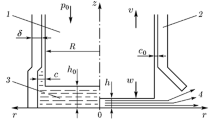Abstract
A model of mechanical initiation of solid explosives, applicable for analysis of sensitivity of individual substances and composite explosives, is developed. The model includes a system of equations of work softening of a high explosive charge under an impact, resulting dissipative heating, and heat release due to chemical reactions between the components of the explosive mixture. The critical parameters and reaction kinetics were numerically calculated for initiation of charges consisting of a mixture of ammonium perchlorate and polymethylmethacrylate. The results are compared to experimental data on sensitivity of this mixture to the impact. Key words: high explosive, impact, explosion, impact sensitivity.
Similar content being viewed by others
REFERENCES
A. V. Dubovik and M. V. Lisanov, “Calculating the critical initiation parameters for a solid explosive in impact on an anvil," Combust. Expl. Shock Waves, 21, No. 4, 459–463 (1985).
A. V. Dubovik, M. V. Lisanov, and E. A. Avdeev, “Calculation of parameters of initiation of solid HE with allowance for localization of plastic deformation under an impact," Khim. Fiz., 5, No. 4, 539–547 (1986).
A. V. Dubovik, “Viscoelastic model of impact ignition of solid explosives," Combust. Expl. Shock Waves, 29, No. 2, 204–211 (1993).
I. A. Karpukhin and V. K. Bobolev, “Critical conditions of impact initiation of some explosive mixtures," Combust. Expl. Shock Waves, 3, No. 3, 232–234 (1967).
V. K. Bobolev, I. A. Karpukhin, and V. A. Teselkin, “Mechanism of initiation of an explosion by impact in mixtures of ammonium perchlorate with combustible additives," Combust. Expl. Shock Waves, 7, No. 2, 221–223 (1971).
A. V. Dubovik, “Approximate method for calculating the impact sensitivity indices of solid explosive mixtures," Combust. Expl. Shock Waves, 37, No. 1, 99–105 (2001).
V. K. Bobolev, V. L. Bodneva, and A. V. Dubovik, “Deformation of lead disks under impact," J. Appl. Mech. Tech. Phys., 16, No. 5, 802–806 (1975).
A. V. Dubovik and V. K. Bobolev, Sensitivity of Liquid Explosive Systems to an Impact [in Russian], Nauka, Moscow (1978).
L. L. Bircumshau and B. N. Newman, “The thermal decomposition of ammonium perchlorate," Proc. Roy. Soc. London, Ser. A, 227, No. 1168, 115–132 (1954); No. 1169, 228–241 (1954).
W. A. Guillory and M. King, “Thermal decomposition of ammonium perchlorate," AIAA J., 8, No. 6, 1134–1136 (1970).
V. A. Koroban, V. P. Guk, et al., “Effect of substituents in the cation on decomposition of ammonium-based perchlorates," in: Chemical Physics of Condensed Explosive Systems [in Russian] (collected scientific papers), Mendeleev Inst. of Chem. Technolog., Moscow (1979), No. 104, pp. 44–51.
Ya. B. Zel'dovich, O. I. Leipunskii, and V. B. Librovich, Theory of Unsteady Combustion of Powder [in Russian], Nauka, Moscow (1975).
Author information
Authors and Affiliations
Rights and permissions
About this article
Cite this article
Dubovik, A.V. Model of Impact Initiation of Composite Explosive Solid Systems. Combustion, Explosion, and Shock Waves 38, 714–722 (2002). https://doi.org/10.1023/A:1021156731273
Issue Date:
DOI: https://doi.org/10.1023/A:1021156731273




